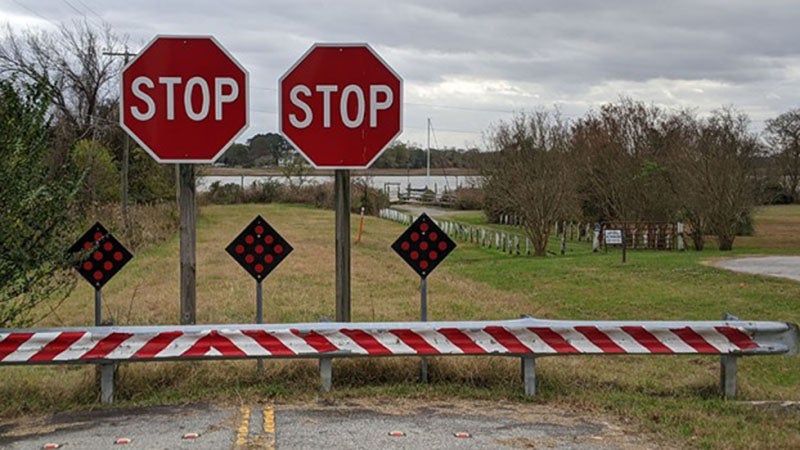Book to recall North Suffolk heritage
Published 9:52 pm Tuesday, July 10, 2012

Karla Smith, Phyllis Spiedell and John Sheally relax outside Arthur’s General Store in Driver Tuesday. They are collaborating on book detailing some interesting history about a part of North Suffolk. Sheally holds a copy of a document co-signed by Richard Bennett, who came to the area in the early 1600s and who established in his will a trust still operating to this day.
How many new North Suffolk residents — or lifelong residents, for that matter — know that what is believed to be America’s, and perhaps the world’s, oldest continuously running charitable trust operates exclusively in their stomping ground?
Probably not that many. But three local history buffs are collaborating on a book that will tell the story, alongside other interesting yarns.
“Peninsula in Passage,” by Phyllis Spiedell and John Sheally, both retired from The Virginian-Pilot, and former schoolteacher Karla Smith, is due out Dec. 1.
Smith chairs the Crittenden-Eclipse-Hobson Heritage Foundation, which, as part of its involvement, has added new board members from the area explored in the book.
The book’s coverage is bound east and west by the Nansemond River and the Suffolk-Chesapeake-Portsmouth boundary, and north and south by the James River and the Wilroy Road area, Spiedell said.
Richard Bennett, after whom Bennett’s Creek would be named, came to the area from England in 1628 to take care of a deceased uncle’s landholdings, Smith said.
Smith describes her role in the book as unearthing records to corroborate and flesh out the stories Spiedell and Sheally discover in interviews.
Meanwhile, Spiedell is also the writer, Sheally the photographer, and Smith also produces the maps.
The three talked recently about their work on the book at Arthur’s General Store in Driver, whose owner, Greg Parker, was one of their many interviewees.
Becoming one of the three richest men in colonial America, the tobacco-growing Richard Bennett ended up the governor of Virginia and, for a shorter time, Maryland, Smith said.
He established a property know to historians as The Poor Farm, where down-on-their-luck farmers could get a second lease on livelihood.
Sheally said farmers living and working at The Poor Farm “didn’t get paid, but they stayed there until they got back on their feet.”
Bennett, who died in 1676, established the trust in his will, Smith said.
It continues to operate to this day as the Richard Bennett Trust, benefiting only the area within the former parish he called home, Smith said, which includes Bennett’s Creek, Driver and some other parts of North Suffolk.
The board consists of local residents, Smith said, and it very carefully selects the community groups and causes it supports.
“Over the years they have also helped specific people in need with scholarships,” Spiedell added.
Sheally marveled, “We think it’s the best thing in the world that that man, in the 1600s, knew to put this together.”
Richard Bennett was “a Cromwellian who became a Quaker,” Sheally said. “He probably had a different take on things,” he added.
Among other episodes to be explored in the book is the first meeting between the Nansemond Indians and early settlers.
“There were people settled here in 1622, when the first massacre occurred,” Smith said. “There were settlers here at the same time that Jamestown was struggling to survive.”
Remnants of a settlers’ fort were discovered during the development of Harbour View.
The book will help people in the areas it covers establish a connection to where they call home, according to Spiedell.
“Lots of new people are moving into the area, and they will go past the cow at Bennett’s Creek Market and not know anything about the area,” she said.
“There’s as much history in this area as there is in Jamestown,” Sheally adds. “It goes back to the Revolutionary War, the Civil War; we have come up with handwritten letters from the Civil War. It’s just incredible.”
Spiedell adds, “What we’re trying to do with this book is, the more you know about where you live, and its history and heritage, the more you appreciate where you are.”
The book will complete a trilogy on the area. Speidell, Sheally and Smith also collaborated on “The River Binds Us,” about Crittenden, Eclipse and Hobson, and “Chuckatuck: Crossroads in Time.” Sheally and Spiedell also worked together on a book about the paper mill in Franklin.
Source material for “Peninsula in Passage” will be compiled in an online database in early 2013. It will be available at www.suffolk-river-heritage.org.






